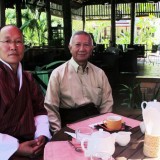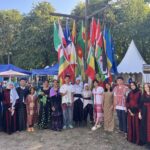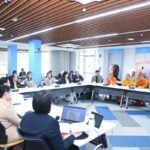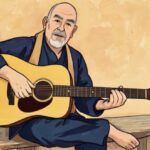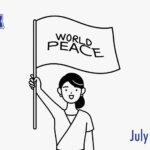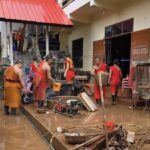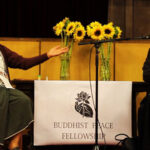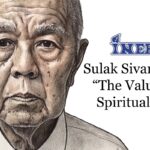 Bigger than France in size, Myanmar is a magnificently rich country in our neighbourhood. Perhaps nothing can reflect this fact more aptly than the Shwedagon pagoda. The pagoda sits in the middle of Rangon, a sprawling city of five million people, on the only hill for miles around.
Bigger than France in size, Myanmar is a magnificently rich country in our neighbourhood. Perhaps nothing can reflect this fact more aptly than the Shwedagon pagoda. The pagoda sits in the middle of Rangon, a sprawling city of five million people, on the only hill for miles around.According to its origin myth, the structure is said to contain eight miraculous strands of Buddha?s hair that was given to two merchant brothers from Myanmar just days after his enlightenment. Historians agree that the pagoda could be referenced in old literature from the 11th century onwards though it was built into its present form over many centuries starting with the Mon Kings who ruled the present day Yangon region.
It is an enormous golden structure, nearly 100 metres high, shaped something like an upside-down funnel, with an octagonal base, a rounded dome, and a long spire. The lower sections are covered in gold leaf, the upper section in plates of solid gold. Altogether, the Shwedagon is said to be enveloped in no less than sixty tons of gold. More than in all the vaults of the Bank of England, the Burmese used to say during the British rule that lasted for well over a century 1948.
Myanmar is rich in natural mineral resources such as petroleum, timber, tin, zinc, copper, tungsten, lead, coal, marble, limestone, precious stones, natural gas and hydropower potential. Myanmar is also fortunate in possessing huge areas of teak and other hardwoods. According to the most recent UN World Development Report, Myanmar has an estimated natural forest area of 43 percent.
Despite the vast reserves of natural wealth, Myanmar remains a mystery today to many outsiders. After its independence from Britain, Burma (as the country was formerly known) came under military rule due to persistent insurgencies. Myanmar has about 135 distinct ethnic groups which are classified into eight ?major national ethnic races.? There are at least 10 major armed ethnic groups who are fighting with the central government for more autonomy in resource use and cultural expression.
The Western governments have enforced long standing aid and trade sanctions on the country, forcing the country into a state of isolation and disrepair. As a result, there is large scale impoverishment in the country that extends from its economy to its education and social welfare systems.
However, ever since 2011, there has been a genuine attempt at comprehensive, inclusive and long-term reforms beginning with the establishment of multi-party democracy and easing of economic restrictions. Aung San Suu Kyi was freed from her two decade long house arrest and her party was allowed to run for the parliament which it did with overwhelming success.
President Thein Sein has also introduced a slew of new reforms aimed at making Myanmar ?a modern, industrialized country? with a strong agricultural sector. Among others, the former military general has introduced a market-oriented exchange rate, which had been a source of lack of market confidence and economic instability. Addressing the 1st Myanmar Development Cooperation Forum in the capital city Nay Pyi Taw on January 19, the President said liberalization of trade and investment, building infrastructures, and developing transparency will be crucial to Myanmar?s success in the future.
A delegation of the Centre for Bhutan Studies led by Dasho Karma Ura was invited to meet with the Chief Economic Advisor of the President of Myanmar, Dr U. Myint and representatives of other leading NGOs and CSOs like Metta Foundation and Spirit in Education Movement in Yangon from January 16-18. The delegation also met a representative of the 88 Generation Group that is composed of student activists who were incarcerated for their political activities.
Speaking with Dr U. Myint, the man who orchestrated the coming together of the two leading personalities of Burma, President Thein Sein and the Opposition leader Aung San Suu Kyi, Dasho Karma Ura said that GNH could deliver breakthroughs and inspirations on the two crucial issues facing Myanmar.
GNH is a philosophy of peace as much as it is of moderation and reconciliation. Given its underpinning in Buddhism which is the religion of about 80 percent of the people in Myanmar, people will easily identify with the search for not only external peace that is promoted by GNH, but also peace within the individual by being able to recognize the things which make an individual agitated and ill at ease.
As it is, Myanmar is today at a crossroad. A new civilian government has been formed and there is an unprecedented mood for peace and progress. As the country sets out on a new path to development, helped in parts by the lifting of restrictions heretofore imposed by the West, Dasho Karma Ura said that GNH can give the country a holistic paradigm for development. As everything starts anew, the country has the opportunity to select a path that leads to a sustainable future with the right care to its spiritual and physical environment.
It was agreed that a GNH conference in Myanmar could provide a platform for leaders of all ethnic groups and political persuasions to come together and find common ground in an ideal that is above narrow self interest and mutual mistrust. It could also help in maintaining the momentum of the initiatives for peace and progress that has resulted in the government agreeing on ceasefire with ethnic rebels except the Kachin fighters.
Dasho Karma Ura also said that a GNH conference could also see a sharing of mutually beneficial experiences and wisdom between two countries penetrated deeply by Buddhism. There are more similarities between Bhutan and Burma than differences. Apart from Buddhism, the Tibeto-Burman language family unites the people in the region. Like Bhutan, people in Myanmar also take pride in wearing their traditional costumes in public and private spaces.
In Yangoon, one can?t help but agree with the noted Burmese writer Thant Myint-U, a descendent of the former UN Secretary General U Thant who has said ?for now at least, there is a new optimism, a new energy. If the country can forge a new path, and end the civil war once and for all, rebuild its shattered education sy
stem, and channel this energy towards creating jobs and raising incomes for all its people, it won?t be a moment too soon.?
GNH, it seems, can help in meaningfully engaging the people and their leaders, and ensure that this positive new energy is harnessed in sustaining the momentum of change and wholesome progress. Bhutan?s genuine leadership in bringing wholesome global peace and harmony through such vital interventions can help this wounded giant in our region, a fellow Buddhist nation shake off its scar from years of decadence and emerge as a dynamic force in shaping a brighter collective future for the betterment of the world.
Contributed by Dendup Chophel
?
Credit : http://www.kuenselonline.com/gnh-and-resurrection-in-myanmar/#.UREVo_JJYuw

